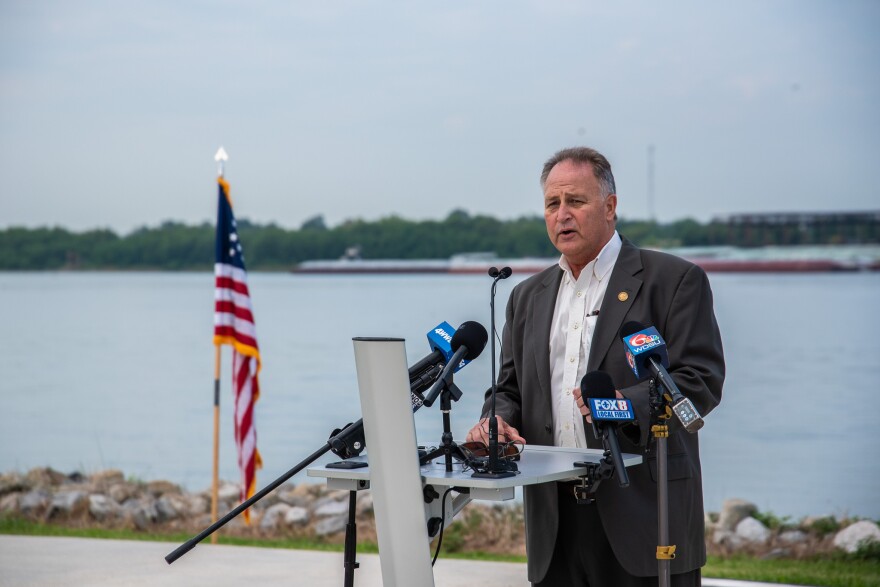As the Mississippi River drops to one of its lowest levels in recent history, the U.S. Army Corps of Engineers said salt water from the Gulf of Mexico could threaten drinking water as far north as New Orleans’ French Quarter if no action is taken.

On Friday, the Corps announced plans to avoid that scenario by building upon an existing underwater barrier that has been in place to block the progression of salt water from intruding farther upriver since July. At its current height, the Corps expects the salt water creeping up the bottom of the Mississippi River to overtop the barrier later this week, sometime around Sept. 22.
If that were to happen, the salt water would begin affecting drinking water in Belle Chasse by early October.
A pervasive drought throughout the Mississippi River Valley allowed seawater to encroach inland earlier this summer. By June, the residents living in lower Plaquemines Parish were forced to go without fresh drinking water and have been relying on water distributed by the parish.
Currently, Plaquemines Parish President W. Keith Hinkley said about 2,000 residents can’t drink their water due to salt contamination, and the parish has distributed more than 1.5 million gallons of water with little signs of reprieve. If the salt water reaches Belle Chasse, at least 20,000 more residents would be affected.
This phenomenon, known as a “saltwater wedge,” typically occurs once per decade. But 2023 marks the second year in a row where drought has left the Mississippi River’s flow far lower than normal.

Army Corps Col. Cullen Jones said forecasts suggest the river’s flow could drop to 130,000 cubic feet per second by mid-October, less than half of the amount of freshwater needed to push the salt water back down to the Gulf of Mexico.
The lowest recorded flow down the Mississippi River happened in 1988, dropping to just 120,000 cubic feet per second, allowing the wedge to intrude as far north as Kenner.
“So while the river level is not unprecedented, we are very close, and with no rain forecasted in the valley, we do not predict positive outcomes for the near future,” Jones said.
The wedge is made up of a dense strip of ocean water that sinks beneath the river’s freshwater during periods of low flow and slowly pushes north under the fresh layer. This happens because salt water is denser than fresh and because the bottom of the Mississippi River is below sea level throughout the entire length of Louisiana.
The Corps’ current underwater barrier, or sill, will block the wedge’s migration near Alliance, about 13 miles south of Belle Chasse and nearly 64 miles upriver from the Mississippi’s mouth. As of Sept. 13, the tip of the wedge extended about 56 miles upriver from the mouth, according to the Corps’ website.
Jones said they want to raise the sill, while still allowing ships to pass by creating a notch in its center. That notch will be a 625-foot stretch that sits about 55 feet beneath the water’s surface, while the wings would sit about 25 feet higher. In that location, the whole river is about 2,700 feet wide.
But without more rainfall in the drought-stricken Mississippi River Valley, Jones said this plan will likely only be enough to buy the Corps additional time to provide Plaquemines and St. Bernard parishes with more resources.

Jones said the Corps will also look into the possibility of shipping enough freshwater from higher up the river in barges down to affected water-treatment plants in order to dilute the saltiness to safe drinking levels. The agency will also give smaller treatment plants technology to remove the salt and purify the water. The units use reverse osmosis to desalinate water by pushing it with extremely high pressure through a thick filter.
Officials said that if your water supply becomes tainted with seawater, do not drink it unless otherwise advised. Ingesting salt water can lead to health problems like high blood pressure. Residents should also be on the lookout for damage to appliances like dishwashers or coffee machines because salt water can be corrosive.

As the planet continues to warm due to human-caused climate change, extreme weather like droughts is expected to happen more frequently than in the past.
“What we can see is just the facts of extreme weather events occurring in more frequent periods. We've seen the implementation of the saltwater wedge in the period of less than a year, and we're also undergoing a significant drought that's pretty much becoming comparable to the 1988 drought,” Jones said.
When asked if long-term adaptation is needed, Jones said the Corps is undergoing a 5-year study of the lower Mississippi River that will examine the effects of more saltwater intrusion and ways to reduce its impact in the future.
Climate scientists agree that the main way to reduce the potential impact of climate change is to steeply, and quickly, cut new greenhouse gas emissions, driven mainly by burning fossil fuels like oil and gas.






